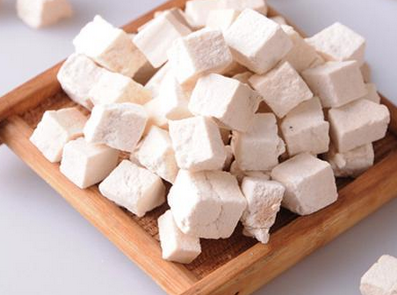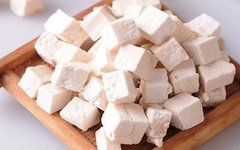 Poria Cocos (Fu Ling)
Poria Cocos (Fu Ling)


Poria Cocos, known as Fu Ling, is a traditional Chinese medicinal fungus derived from the dried sclerotium of the fungus Poria cocos (Schw.) Wolf, belonging to the family Polyporaceae. It is harvested primarily between July and September. After excavation, the sclerotia are cleaned of soil, subjected to a “sweating” process, and then spread out to dry until the surface is dry. This process is repeated until wrinkles appear and most of the internal moisture is lost, after which it is dried in the shade. The resulting product is referred to as “Fu Ling Ge”; alternatively, fresh Poria can be cut into different parts and dried, resulting in “Fu Ling Kuai” and “Fu Ling Pian”.
 Pharmacological Effects
Pharmacological Effects
1. Diuretic Effect
The decoction of Poria (3 grams or commonly used clinical dosage) does not exhibit diuretic effects in healthy individuals. In dogs, intravenous injection of the decoction at 0.048 grams/kg also does not increase urine output, nor does it show significant effects in rats or rabbits. However, its ethanol extract has been reported to induce diuresis in rabbits when injected intraperitoneally, and water extracts have shown diuretic effects in chronic experiments. The decoction can promote sodium excretion in adrenalectomized rats, indicating that the diuretic properties of Poria warrant further investigation. Poria contains 97.5 mg% potassium; when calculated for a 30% water decoction, it contains 0.186 mg/mL sodium and 11.2 mg/mL potassium. Therefore, the promotion of sodium excretion is not related to its sodium content (which is too low), while the increase in potassium excretion is associated with its high potassium salt content.
In chronic ureteral fistula dogs (intravenous injection), healthy individuals, and rabbits (oral decoction), Wu Ling San (Five-Ingredient Powder with Poria) shows significant diuretic effects. In dogs, it increases the excretion of sodium, potassium, and chloride, with the main diuretic components being Gui Zhi (Cinnamon Twig), Ze Xie (Alisma), and Bai Zhu (White Atractylodes). Reports indicate that oral administration of Wu Ling San decoction to rats at doses up to 1 gram/100 grams has not demonstrated diuretic effects.
2. Antibacterial Effect
No antibacterial effects of Poria have been observed in vitro. However, its ethanol extract can kill Leptospira, while the water decoction is ineffective.
3. Effects on the Digestive System
Poria has a direct relaxing effect on isolated rabbit intestines and can prevent ulcers formed by pyloric ligation in rats, as well as reduce gastric acid secretion.
4. Other Effects
Poria can lower blood sugar levels, and tinctures or infusions can inhibit isolated toad hearts, while ether or ethanol extracts can enhance cardiac contraction. It does not have an antiemetic effect on vomiting induced by digitalis in pigeons.
 Properties and Channels
Properties and Channels
Flavor: Sweet, Bland; Nature: Neutral.
Enters the Heart, Lung, Spleen, and Kidney channels.
 Indications
Indications
Promotes urination and resolves dampness, strengthens the spleen, calms the mind.
Indicated for edema, reduced urination, phlegm-dampness causing dizziness and palpitations, spleen deficiency with poor appetite, loose stools, anxiety, and insomnia.
 Related Formulations
Related Formulations
1. For nocturnal emissions and turbid discharge: 1 liang of snow-white salt (to consolidate and eliminate fire toxins), 1 liang each of Bai Fu Ling and Shan Yao (Chinese Yam). Grind into powder, mix with jujube flesh and honey into pills the size of a walnut. Take 30 pills with jujube decoction. This formula balances sweet and salty, benefiting both the spleen and kidneys. (From Zhi Zhi Fang)
2. For post-epileptic edema: After a child recovers from epilepsy, if there is deficiency of blood and qi, and heat in the skin causing swelling all over the body, mix equal parts of Wei Rui (Asparagus), Kui Zi (Coriander), Long Dan (Gentian), Poria, and Qian Hu (Peucedanum) into powder. Take 1 qian (3 grams) with water decoction. (From Sheng Ji Zong Lu)
3. For kidney deficiency with turbid discharge: Equal parts of Rou Cong Rong (Cistanche), Lu Rong (Deer Antler), Shan Yao, and Bai Fu Ling, ground into powder, made into pills the size of a walnut, taken with jujube decoction. (From Sheng Ji Zong Lu)
 Contraindications
Contraindications
Should not be used in cases of deficiency-cold with slippery essence or qi deficiency with sinking.
1. Ben Cao Jing Ji Zhu: “Ma Lin is a contraindication. Avoid Bai Lian, Di Yu, Xiong Huang, Qin Jiao, and Gui Jia.”
2. Yao Xing Lun: “Avoid rice vinegar.”
3. Zhang Yuan Su: “If there is frequent urination or diarrhea, it can harm the eyes. If taken with excessive sweating, it can damage the vital energy.”
4. Ben Cao Jing Shu: “Patients with kidney deficiency, spontaneous urination, or slippery essence should not take it.”
5. De Pei Ben Cao: “Avoid in cases of qi deficiency with sinking, dry mouth, and thirst.”
 Identification of Medicinal Material
Identification of Medicinal Material
Poria Ge is spherical, flat, or irregular in shape, varying in size and weighing from several taels to over ten jin. The surface is blackish-brown or brown, with a thin, rough outer skin and prominent wrinkles, often covered with soil. It is heavy, hard, and difficult to break; the cross-section is uneven, granular or powdery, with a light brown or light red outer layer and a completely white inner layer, with some being light brown, fine, and showing cracks or brown fibrous roots embedded in white fluffy pieces. It has no odor and is sticky when chewed. The best quality is firm, with a brownish outer skin that is slightly shiny, deep wrinkles, a fine white cross-section, and strong stickiness. White Poria is usually cut into thin slices or cubes, white, fine, and powdery, with a brittle texture that breaks easily, sometimes with yellowish-brown edges.
 Related Discussions
Related Discussions
1. Ben Cao Gang Mu: Poria has a bland flavor and promotes dampness; its nature is upward-moving, generating body fluids, opening pores, nourishing the water source, and promoting urination. Therefore, Zhang Jie Gu described it as belonging to Yang, floating and rising, indicating its nature; while Dong Yuan described it as Yin within Yang, descending and lowering, indicating its function.
2. Ben Cao Yan Yi: Poria and Fu Shen (Poria Spirit) have significant diuretic effects and are essential for benefiting the heart and spleen.
3. Ben Cao Zheng: It can promote urination and eliminate dampness, open the orifices to enhance intelligence, and generate fluids; eliminate dampness to dry the spleen, tonify the middle and strengthen the stomach; dispel fright and seizures, nourish the intestines, treat phlegm, and assist in the descent of other herbs. Its slightly sweet flavor is said to tonify Yang, but it is more diuretic than tonifying.
Harbin Medical University Daqing Campus New Media Center
Text and Image Editor: Zhuang Wei Yao
Editor: Gao Jing Yu
Reviewer: Chi Ming Zhu
Submission Email: [email protected]
We welcome everyone to actively submit!


